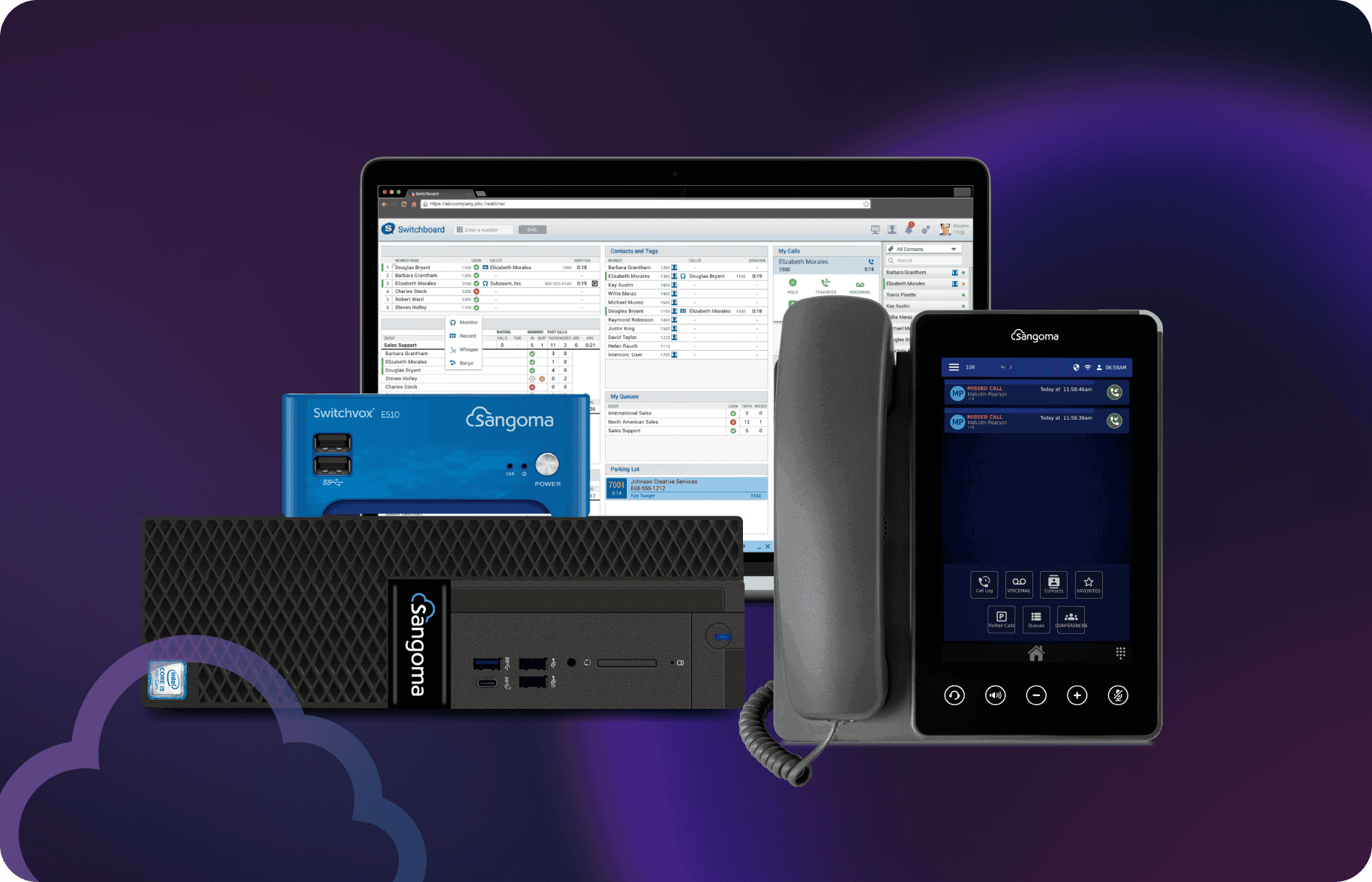On-premises UC: A Reliable Choice for Regulated Industries

For industries with strict compliance requirements or data sovereignty concerns, keeping communication infrastructure in-house can offer added peace of mind. On-Premises Unified Communications (UC) gives you full administrative control over updates, integrations, and data—without sacrificing the collaboration features teams rely on.
While cloud and hybrid deployments are secure and scalable (and often the right fit for many businesses), some organizations still need the certainty of managing everything on-site. On-prem systems from Sangoma deliver that—plus long-term cost savings and full integration with existing hardware.
Need help deciding which UC setup is right for your business? Check out our Complete Guide to Unified Communications Solutions.
What is an On-Premises Unified Communications System?
An on-premises UC system is a business communication platform hosted entirely on-site, meaning all data, hardware, and software are managed internally. This setup provides organizations with complete autonomy over their communication network, ensuring compliance with strict regulations and reducing reliance on third-party providers. It integrates voice, video, messaging, and collaboration tools within a private infrastructure, delivering maximum security and performance.
Why Regulated Industries Rely on On-Premises UC
Data Security & Compliance
Regulated industries have to follow very strict data security guidelines, and on-prem UC ensures data sovereignty by keeping sensitive information within the company’s infrastructure. It uses high-level encryption to protect calls, messages, and video conferences to reduce any unauthorized access. Additionally, businesses can meet compliance requirements for laws like HIPAA (healthcare) and PCI-DSS (finance) without depending on external vendors.
Control Over Communication Infrastructure
Unlike cloud UC, where service providers dictate security protocols, updates, and pricing, on-prem UC puts businesses in the driver’s seat. Organizations avoid vendor lock-in, tailor security measures, and maintain complete control over system updates and configurations. This autonomy ensures higher reliability and reduces external provider risks.
Reduced Disruptions and Surprises
Many companies face unexpected challenges with some cloud providers, such as sudden price hikes or service outages. That’s part of why regulated industries often lean toward on-prem UC—so they can monitor uptime in-house and stay in control of their environment.
That said, Sangoma’s own cloud and hybrid systems are built differently—with 99.999% uptime and built-in redundancy to keep your business running without disruption. For teams that need local survivability and the flexibility of remote access, Sangoma offers a unique hybrid deployment option.
Ease in Meeting Industry-Specific Compliance Requirements
For almost all businesses, compliance isn’t optional—it’s a necessity. An on-premises UC system simplifies compliance by supporting industry-specific security policies, keeping detailed audit logs, and enabling localized data storage to meet legal requirements.
Cost Considerations & Long-Term Investment
While on-prem UC requires a higher upfront investment, it often proves to be a more cost-effective long-term solution. Businesses save money by eliminating ongoing subscription fees and gaining full control over maintenance and upgrades. Unlike cloud-based models, which often increase costs over time, on-prem UC provides predictable expenses and avoids external pricing fluctuations.
Regulated Industries That Can Benefit From On-Premises UC Deployment
Healthcare
With HIPAA regulations requiring strict patient data protection, on-prem UC helps secure telehealth consultations, protect medical records, and encrypt patient communications. Healthcare providers can ensure compliance without relying on third-party cloud services.
See Sangoma’s UC solutions for healthcare.
Retail
Retailers handling credit card transactions and customer data benefit from enhanced POS security, reliable store-to-HQ communication, and improved customer service through secure call handling. On-prem UC ensures data protection and seamless operations across multiple locations.
See Sangoma’s UC solutions for retail and restaurants.
Education
Educational institutions must safeguard student information. A secure UC system supports campus-wide messaging, prevents breaches of student data, and provides a reliable infrastructure for online learning platforms.
See Sangoma’s UC for education offerings.
Manufacturing
Factories require secure communication to manage operations effectively. On-prem UC safeguards trade secrets, enables real-time coordination across manufacturing plants, and reduces downtime with local system control.
See Sangoma’s UC solutions for manufacturing.
Hospitality
Hotels and resorts rely on UC for smooth operations. An on-premises setup supports front desk and room service communication, ensures secure guest interactions, and provides reliable staff coordination without the risk of cloud downtime—even during inclement weather when connectivity may be compromised.
See Sangoma’s UC solutions for the hospitality sector.
Government & Defense
For government and defense organizations, secure communication is critical. On-prem UC protects classified communication, ensures national data sovereignty, and provides secure voice and video conferencing channels to maintain operational security.
Factors to Consider for Deploying an On-Premises UC Platform
Compliance & Regulatory Requirements
Before implementing an on-prem UC system, businesses should conduct compliance audits, establish strong data governance policies, and ensure alignment with industry regulations. Failure to do so can result in legal complications and security vulnerabilities.
Security & Data Privacy
A secure UC system should include end-to-end encryption, multi-factor authentication, and regular security audits. Organizations should also prioritize secure data storage and proactive threat monitoring to prevent breaches and cyberattacks.
Total Cost of Ownership (TCO)
To assess financial feasibility, businesses must compare upfront infrastructure costs with long-term maintenance and licensing expenses. While the initial investment may be significant, the absence of ongoing cloud subscription fees can lead to substantial savings over time.
IT Resources and Technical Expertise
Running an on-premises UC system means your internal IT team is responsible for setup, monitoring, updates, and troubleshooting. If your organization doesn’t already have dedicated technical staff, you’ll need to factor in hiring or training costs. The trade-off is greater control—but it comes with added responsibility.
Scalability and Integration Elements
As your business scales, your communication needs evolve. A scalable UC system should support expansion, enabling seamless integration with CRM, ERP, and collaboration tools. Future-proofing ensures that the system remains efficient and adaptable.
Vendor Support for On-Prem Deployment
Even with an in-house IT team, having a UC provider that knows on-prem environments inside out makes a difference. Look for a partner that offers responsive support, clear documentation, and a proven track record in security and compliance. With the right vendor, your team gets the tools, guidance, and backup needed to keep things running smoothly long after deployment.
Failover and Redundancy Mechanisms
Downtime isn’t an option in regulated industries. That’s why your on-prem UC setup needs built-in failover paths and real-time monitoring. Look for options like redundant internet connections, backup power, and automatic call rerouting. A strong disaster recovery plan should cover system snapshots, offsite backups, and fast restore procedures. When everything’s managed in-house, these safeguards give you full control over uptime—even in a worst-case scenario.
Considering a Shift From On-Prem to Cloud or Hybrid UC?
While on-prem UC offers full control, many IT teams eventually explore cloud or hybrid options to simplify maintenance, reduce hardware dependencies, or support multi-site growth. Moving to a cloud-based or hybrid deployment doesn’t mean sacrificing security or performance—it means reallocating resources to where they matter most.
Migrating from on-prem to UCaaS or hybrid models typically involves porting phone numbers, mapping existing call flows, and reconfiguring user permissions and routing logic in a hosted environment. If you’re using Sangoma hardware like Switchvox or phones already, much of that equipment can carry over to cloud or hybrid setups with minimal reconfiguration. Sangoma also provides tools for syncing contacts, managing extensions, and testing call quality before you cut over, reducing risk during transition.
With Sangoma, you don’t have to overhaul your existing setup to make the switch. Our platforms are designed for gradual migration, so you can modernize at your own pace—without disrupting operations or losing the control you value.
Deploy an On-Prem UC Solution Tailored to Your Industry Needs
If you work in a regulated industry, you don’t just need reliable communication—you need control. On-prem UC gives you that, with the security and stability your operations demand.
Sangoma has decades of experience supporting industries where compliance and uptime aren’t optional. If you’re looking to modernize without compromising control, we’ll help you build a solution that fits your infrastructure, your policies, and your team.
Let’s figure out what makes sense for you—get in touch here.




